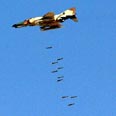
Iran jets in long-range training
Expert tells Ynetnews reported Iran air force exercise may be tied to Israel, but threat not major
At the same time, experts said they doubted Iran's air force was anywhere near a stage of development that could challenge Israel's Air Force.
At the beginning of February, Jane's Defense Weekly reported that "Iranian pilots are stepping up training and exercises for long-range missions."
Quoting "Western defense sources," the report said "Iran is pursuing a longer-range strike capability for its air assets to support the delivery of more powerful strategic weapon systems," adding that Tehran was "investing considerable resources" in aerial refueling capabilities. The training involved Iran Air Force's (IRIAF's) Sukhoi Su-24MK strike aircraft, Jane's Weekly said.
The aerial refueling exercises, originating out of the Tactical Air Base 7 in Shiraz, southwest Iran, take place at night and involve planes flying at very low altitudes, the report continued. The exercises were aimed at simulating "operational scenarios that would entail night-time refueling of an Iranian attack aircraft, at low altitude over the Mediterranean, outward bound en route to the target," Jane's Weekly added.
'Iran jets can reach Israel'
Dr. Ephraim Kam, who teaches securities studies at Tel Aviv University, and is Deputy Head of the Jaffee Center for Strategic Studies, confirmed that Iran possesses long-range warplanes. "They don't have many, but the Sukhoi Su-24 can also reach Israel. Iran also has a certain ability - though I'm not sure to what extent - to refuel in the air," Kam said.
"They could be taking Israel into account during their training," Kam said, adding: "It's logical, because if Israel attacks, they would want to respond. If they reach a nuclear ability, they may also want to have the option of using planes to launch nuclear missiles, and not rely solely on the Shihab 3 missile. This can't be ruled out," Kam said.
Kam added that Israel has been aware of Iran's air force capabilities for many years. "Against the Israeli Air Force, these planes are not very significant. They are not so developed in their long-range attack abilities. The Iranians are not sufficiently familiar with the Israel arena, and the Israeli Air Force (IAF) is much more developed. I assume Israel has answers to this," he said.
'Israel not at top of target list'
Yizhak Shapir, an expert on Iran's military capabilities, also of the Jaffee Center for Strategic Studies, told Ynetnews that Israel was not at the top of Iran's target list. "Strategically, Israel is in a fairly low place on the list of Iran's targets," he said, adding: "It's not in first place."
"Ideologically, Israel is seen as an envoy of West. Strategically, they have many targets to look for, and they are looking to develop their air force capabilities," Shapir said.
"After saying that, it's also important to say their air force is small and weak, and certainly not close to being able to deal with IAF. Their warplanes – the Sukhoi Su24, are from the 1980s. Their capabilities are from the last generation. They have a relatively small number of planes," Shapir noted.
'Israel is publicly-stated destination'
Professor Raymond Tanter, founder of the Iran Policy Committee, did not specifically comment on the report by Jane's, but did suggest that Israel was in first place in Iran's list of targets. He underlined in an email sections of a recent book he co-authored, titled What Makes Tehran Tick, which he said "provides our latest thinking on the Iranian missile threat and motivations of the regime."
"Israel is the publicly-state destination of these missiles. Such targeting is not only declared in speeches of Iran's top leadership, but also inscribed on the fuselages of the missiles," the book passage said.
"At the same time, Iran is developing ideas for deceptive weaponry, such as transferable warheads. Iran's ballistic missile development is racing ahead in much the same way as its uranium enrichment, formulating missiles that could be fitted with the nuclear, chemical, or biological weapons as well as the conventional warheads that most of them were designed to carry," the book added.
Referring to Hizbullah's role in Iran's targeting of Israel, the passage continued: "Since the Shahab-3 was not used during the 2006 war in Lebanon, Iran may have been authorizing a closely-located third party to strike back strategically if the need arose, such as a response to an Israeli strike on Iran's nuclear program."










